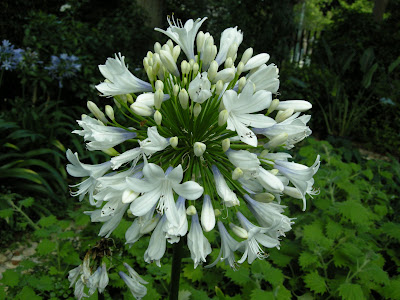I am very lucky to have a friend who has a research permit for Orange Kloof which means we can walk there without an guide. Saturday morning we set off, up Constantia Corner which offers lovely views over Hout Bay and Orange Kloof (on the right of the pic).


I've been up Constantia Corner many times, and we did the same walk a year ago, so the plant populations en route are familiar to me - it felt like I was checking up on old friends.

My favourite part is right on top of the mountain, with grassy-restiod fynbos and those sculptural sandstone rocks - and no sign of the City or human habitation. We had coffee and croissants at the rock shelter.

Then past Camel Rock and the Overseer's hut (now some kind of Hoerikwagga lodge, complete with surburban latte fence) and over the Hely Hutchinson dam wall...


Finally we dropped down into Disa Gorge into the resticted Orange Kloof. The wall is made of the local grey sandstone which has been beautifully hewn into massive rectangular blocks. I admit I have a penchant for bold feats of engineering like bridges, dams and stone aqueducts in wild landscapes. They have a scale and sculptural quality which appeals to my senses.


Not the same dam wall, but another one close by, showing the quality of the stone work (March, 2010).

The path drops into a forested kloof, and for a little while the vegetation is lush and the extra moisture is tangible. Here is Marie, on our walk a year ago.
This time Mike and I stopped for a few flowering disas, but my eye was irresistably drawn to the pretty new foliage of
Blechnum.


Red Disa,
Disa unifloraWhy do we always take pictures of the perfect flower? Here is the one next door: it think it's pollinia were eaten - noshed by a hungry beetle rather than removed by its delicate pollinator, the Mountain Pride butterfly.

Along the way Mike kept a count of Mountain Pride butterflies - he had eight sightings in all.
Meneris tulbaghia is the sole pollinator of a guild of orange and red flowered fynbos species which flower between November and March. The butterfly is unusual in that it one of few insects that can see red in the visible spectrum - and is therefore the sole insect pollinator of these red-flowered plant species. I have seen it swoop down on a red backpack or hiker's socks, and even a red Opel Kadett!
Along our path and on the butterfly's menu, so to speak, were:
Crassula coccinea, Red Disa (
Disa uniflora) and
Tritoniopsis triticea.
 Crassula coccinea
Crassula coccinea, Klipblom
Although we didn't see the Cluster Disa (
Disa ferruginea), this species is also visited by the Mountain Pride Butterfly. It is interesting that the disa doesn't offer a nectar reward and mimics
Tritoniopsis, a nectar-producing irid. When the butterfly visits the Cluster disa, and sticks its proboscis down the floral tube in search of nectar, there's nada! nothing there - but the disa deposits its sack of pollen (pollinia) on the butterfly. It's trickery and deceit in action.
Further along the way there is a nice stand of
Leucadendron strobilinum - another endemic to Table Mountain. Fynbos is characterised by its high degree of endemism, so this is not unusual - in fact I can be a bit blase about it. But actually it
is remarkable that this species is found
only on this mountain and nowhere else in the world. Thank god it is fairly well-protected in the Table Mountain NP (if they finally get round to urgent alien clearing and erosion control in the Park).

 Leucadendron strobilinum
Leucadendron strobilinum is easy to recognise by the fringe of silky white haris on the leaf margins.

Along the way we came across this chap - no idea what he's called. Methinks I need to acquire a reptile book...





























































